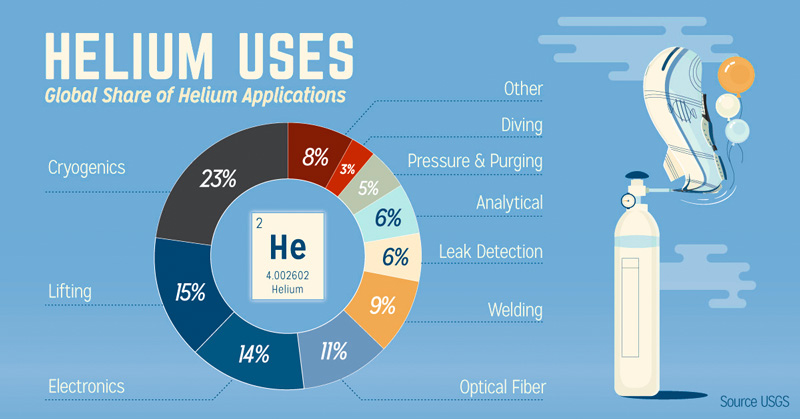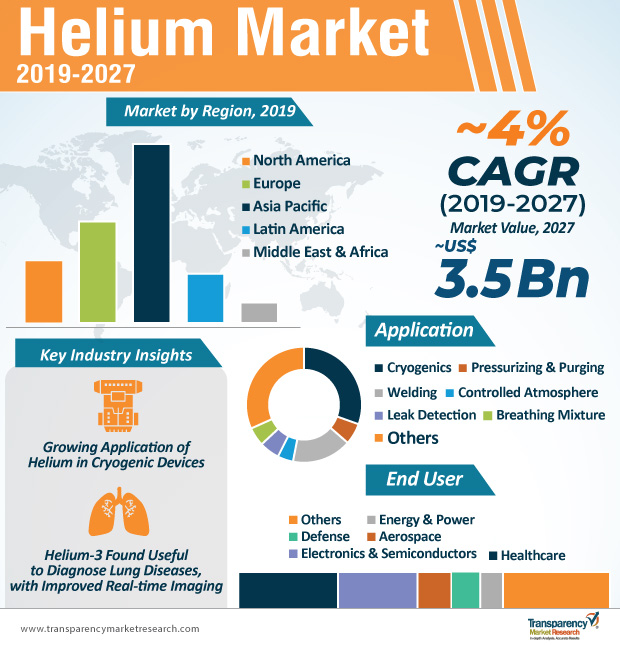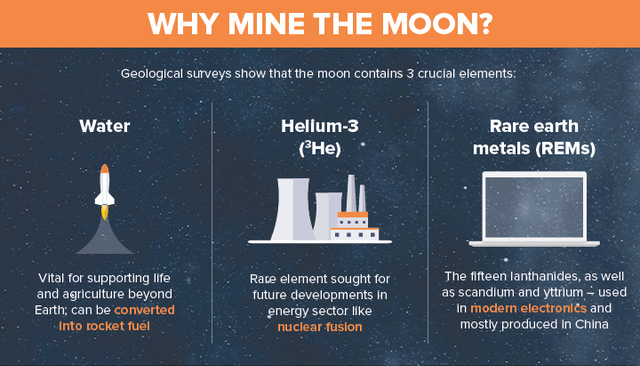Helium: Fuelling the Future?
What is Helium? HELIUM, deriving from the Greek word ‘Helios’, Ήλιος’, meaning ‘Sun’, and with the elementary symbol ‘He’ (in the elements periodic table) is a colourless, odourless gaseous element. Helium is considered one of the noble gases; how could it not be? It is the element of the Sun itself!
Helium has a peculiar and very interesting fact attached to it: it is the only element discovered out of Earth before it was discovered on our planet. It was eventually discovered and isolated around 1895 by Sir William Ramsay, a British chemist, who recovered it from a uranium-bearing mineral. It was concluded that it can usually be found in places where deposits of natural gas exist. The real difficulty lies with the fact that separation and extraction of helium from other gasses is a bit complicated.
The element has some unique qualities. Being non-combustible, helium is preferred to hydrogen as the lifting gas in lighter-than-air itself. Helium possesses 92% of the lifting power of hydrogen, although it bears double the weight of hydrogen. Liquid helium boils at approximately -268.93 Centigrade (4.2 Kelvin) and will not freeze at atmospheric pressure conditions. Solid helium will form when pressures above 20 times atmospheric are provided.
Liquid helium, due to its extremely low boiling point, can be used in cryogenic systems when temperatures below the boiling point of nitrogen are required. The way to cool down objects is to submerge them in liquid helium or liquid nitrogen. Liquid helium and nitrogen are usually stored in vacuum insulated flasks (we commonly know these containers as ‘thermos’), officially called ‘Dewars’, named after their inventor, Sir James Dewar. Liquid helium is probably the coldest fluid that exists in nature. That being said, the unwanted substances that lie within liquid helium, or ‘impurities’, will be in a frozen, solid condition which makes it relatively simple to eliminate and get ‘optically clean’ liquid.
Within the cryogenics scientific community, they distinguish the different kinds of helium. The main distinction is between the two naturally occurring isotopes, Helium 3 and Helium 4. Helium 4 makes up over 99% of the natural Helium, therefore this is the Helium we refer to when we do not specify the isotope. Helium 3 (He3) is in fact the rarer isotope, and boils at 3.2 Kelvin, one degree less than Helium 4. Both isotopes can be cooled to below their boiling temperatures by regulating pressure, reaching points below atmospheric pressure. Liquid helium, behaves like water boiling at lower temperatures if pressure is lower.
But there is also the curious case of Helium 2, an extremely unstable – and still very interesting – isotope. In order to explain its strange behaviour, scientists established the two-fluid model. Helium 2 is depicted as a combination of two fluids: normal helium and superfluid helium. At temperatures just below the lambda point, the temperature at which normal fluid helium makes the transition to superfluid helium, the mixture is almost entirely normal. While temperatures are dropping, more and more of the substance becomes superfluid.
Here are some of the very interesting properties of the superfluid helium:
- It carries no thermal energy, which means no entropy;
- It has no viscosity, no thickness, and therefore is can be deformed instantly (flow through gaps, for example);
- It naturally ‘seeks’ heat, which converts the superfluid to normal. The flow of superfluid into any heated area will cool that area and restore the uniform mixture of normal and superfluid.
Applications and uses
There is no question as to whether an element with such unique properties can have useful applications. More specifically, Helium is absolutely vital for a wide range of activities and industries. For example, it is being used for rocket fuel pressurization purposes. It can purge semiconductor atmospheres, calibrate analytical instruments, inflate airplane tires and airbags. It can also be used to test for leaks in pipe systems, inflate large balloons for meteorological studies and let’s not forget the inflation of smaller balloons for children parties.
More specifically, Helium is being used to pressurize and stiffen the structure of rockets before launching as it remains a gas even at the low temperature of liquid hydrogen; similarly, it pressurizes the fuel tanks in order to force the fuel into the rocket engines. Because the tanks are so cold, other liquids would freeze and clog the system. Additionally, while other types of material could react badly with oxygen within tanks resulting to explosions, Helium is inert and won’t combust.
Additionally, Helium is an excellent alternative to replace nitrogen as part of the synthetic atmosphere breathed by deep-sea divers, caisson workers, and others, because it reduces susceptibility to the bends. This artificial atmosphere is being used by doctors to relieve patients of severe respiratory conditions because helium is much more ‘fluid’ than nitrogen and can flow easier through constricted respirators.
Helium is usually transported in a gas form, compressed in steel cylinders. When it comes to larger amounts it is shipped as a liquid in insulated containers, saving shipping costs.
According to a U.S. Geological Survey report, almost 33% of the Helium the U.S. used last year went to cryogenics. Labs all over the world now, use liquid Helium to cool their instruments requiring extremely low temperatures. Those devices measuring magnetic fields for brain cell research need liquid Helium, for example, as do the world’s most powerful magnets. Magnetic resonance imaging (MRI) equipment need liquid Helium to cool the superconducting magnets generating their magnetic field. Modern medicine needs MRIs to diagnose all sorts of diseases, while researchers use them for experiments across all sectors. Newer machines use less Helium but developing a magnet not requiring any Helium will take many years more and might not happen at all, according to the National Research Council.
As we mentioned, Helium is a very stable refrigerant, able to cool things down to extremely low temperatures, more effectively than anything else. For example, liquid Helium cools the superconducting machinery in particle accelerators, including several facilities in the U.S. and the Large Hadron Collider in CERN. Particle accelerators are usually many miles long and need cooling all along their length, thus requiring significant amounts of Helium. There is great efficiency in this application, as once an accelerator is filled with Helium it is able to continually reuse the refrigerant. The only need for refilling occurs due to the small amounts of natural leakage every year.
Helium is also important to Internet use as one of the methods of creating semiconductors requires liquid Helium to cool the magnets during the manufacturing process. Meanwhile, the fibre optic cables provide internet access and cable TV services need to be made in an all-Helium atmosphere to prevent bubbles from getting trapped inside.
Of course, there are also the military applications of the element. The U.S. military’s submarine detectors use liquid Helium, and the U.S. Air Force uses Helium in experiments on superconductors as a power source. Balloons, not only the party ones, require Helium. For example, research balloons and Department of Defence survey balloons use Helium. The DOD is reportedly developing a Helium-filled balloon called JLENS that will be used for permanent surveying of U.S. skies for cruise missiles.
The next generation of nuclear power generators may need Helium as a cooling mean. U.S. labs are working on creating very-high-temperature reactors that would be safer, more efficient, more affordable and faster to construct. Scientists are not really certain yet regarding how much Helium a reactor would require. For more than four decades, scientists have been working on producing power from nuclear fusion rather than fission. In today’s nuclear reactors, the hydrogen isotopes tritium and deuterium are used as fuel, with atomic energy released when they fuse to create Helium and a neutron. Nuclear fusion is actually duplicating the same energy source that fuels stars (like our Sun), and does not produce the radioactive waste as a by-product of current nuclear fission-generated power. However, the so-termed ‘fast’ neutrons released by nuclear fusion reactors fuelled by tritium and deuterium lead to significant energy loss, entropy, and are extremely hard to control. A potential solution could be to use Helium 3 and deuterium as the fuels in ‘aneutronic’ (neutrons-less) fusion reactors. Nuclear fusion reactors using Helium could therefore provide a very efficient form of nuclear power with virtually no waste and no radiation by-products.
Helium though is a non-renewable natural resource and is becoming scarce in the U.S., according to speakers at the U.S. Senate. The U.S. has established a significant Federal Helium Reserve back in the 1920s but the amounts seems to be diminishing. To better meet demand, the Senate hearing considered a bill that would change how the reserve sells Helium. A Helium shortage would affect the U.S. in myriad ways, spanning from high-tech gear development to national security.
Harvesting the Solar System?
Just the thought of interstellar exploration and furthermore exploitation sounds like a science fiction movie. The truth is that Helium-3 (He3) is a gas that has the potential to be used as a fuel in future nuclear fusion power plants. The problem with that idea is that there is very little Helium-3 available on the Earth. With our current capabilities, it is produced as a by-product of nuclear weapons maintenance, which could provide us approximately an amount of 15 kilos per annum.
Early dreamers imagined that Saturn or Jupiter would be the ideal places to try and get their hands on some Helium-3, but it now appears that multiple governments have set their sights on the Moon, where it is believed that there could be significant quantities. The Moon could be offering a lot more than He3 though; to be more specific, it is believed that other than Helium there is an abundance of other raw materials like titanium. As our natural satellite lacks an atmosphere, it has been bombarded by solar winds containing He3 for billions of years. Some of the estimations lead to thoughts of more than a million metric tons of the isotope on the lunar surface. These resources could be extracted by heating the lunar dust to around 600 degrees Celsius, before bringing it back to the Earth to fuel the innovative nuclear fusion generators. Only that amount, given the right conditions, could fuel humanity for thousands of years.
To provide a more specific example, an Artemis Project memo indicates that a fully loaded Space Shuttle cargo of He3 could power the United States of America for about a year. This means that this resource could have a valuation of up to 3 billion dollars per ton. That is definitely motivating enough for anyone in the public or private sector.
The sun is a natural fusion generator but it is massive and the gravitational forces provide ample energy for fusion to take place in the star’s core. Fortunately, or unfortunately, such forces cannot be reproduced by us. Therefore, even if we do eventually start harvesting the solar system, and more specifically the Moon, we do have some Earth-bound technical challenges. The most advanced fusion programs in the world are inertial confinement and magnetic confinement fusion. For both of them, there is no projection for commercial power generation before the next 30 years. The immense cost of such reactors (like ITER and National Ignition Facility) are due to their enormous size, and there is already a projected need to build even larger ones. More superficially, the reaction rates of He3 fusion are not high enough, indicating that a larger reactor might be needed.
As a workaround, a number of other types of reactors have been proposed, though many of them remain theoretical and have indeed fundamental challenges with achieving a net energy gain. It seems for now that the amount of energy we need to achieve He3 nuclear fusion is more than the energy we receive in return.
Lunar-politics?
As noted above, several of the global powers have made announcements that they are either actively considering or would like to go to the Moon and mine Helium-3. Whether the science will actually work or not, it is almost irrelevant at this point. No-one can dismiss the potential of lunar Helium-3 power generation or the rest of the Moon’s resources.
While there are international treaties regarding the notion of exploiting the Moon, they are probably laughable obstacles to a regime like China which is about to go and get their own lunar Helium-3. At the dawn of the 21st century, and while many dismiss that we ever landed on the moon (implying that the space-race was a gambit-hoax of the US to bankrupt the USSR) few could have predicted a second race for the moon so soon. The current race though, will not be like the one from the 1960s, as a full list of global players, including China and India are taking part.
NASA’s Vision for Space Exploration included ‘boots on the ground’ within 2021 and permanently establishing a permanent base there by within the decade. While the U.S. have not officially declared any intention to mine Helium-3, there are strong voices within the agency (NASA) advocating for it.
Russia, on the other hand, through Nikolai Sevastyanov (head of the Russian space corporation Energia) had claimed they would have a base on the Moon by 2015 with He3 mining operations and industrial-scale Helium-3 production by 2020. This is not going to happen apparently, and it might be a play to force the U.S. into spending much more for that purpose (-ironic, right?)
On a more serious note, China landed a robot vehicle on the Moon, back in 2013, successfully completing the ‘middle’ stages of its Lunar Exploration initiative. It was planned that before 2017, the fifth and final stage of the program would come back with lunar material. Apparently, their Chang’e lunar probe series is delivering some solid progress! Chang’e 5-T1 just completed its transfer from the Earth-Moon Lagrange Point 2 back to a stable orbit around the Moon, which is significant enough. The next mission objectives will be to bring back the first samples of fusion-ready He3.
India is following decisively. India’s president, among other government officials, clearly stated their country’s interests in deploying enormous solar collectors in orbit and on the lunar surface. They have also shown interest in He3 mining. At the same time, other players like Japan and the EU are talking about launching their own missions, and about the possibility of mining He3 as well.
Back to Earth
Meanwhile, and back to Earth, the U.S. seems determined to continue its efforts to extract more terrestrial helium. The U.S. Geological Survey found Qatar and Algeria could have major helium deposits, but because a domestic supply would be much cheaper, it seems to be the most cost-effective solution.
“It’s highly unlikely if the United States does not make advances to seek out new gas-bearing fields for helium,” officials have stated referring mainly to quantities allegedly found in several states like Wyoming, Utah and Arizona.
Advocates of He3-based fusion highlight that the current efforts to develop fusion-based power, like the humongous ITER project, use the deuterium-tritium fuel cycle, which is fundamentally problematical. Deuterium and tritium are hydrogen isotopes, and when they’re fused in a superheated plasma, two nuclei come together to create a helium nucleus–consisting of two protons and two neutrons–and a high-energy neutron. A deuterium-tritium fusion reaction releases 80% of its energy in a highly destructive stream for anything that stands in it way, including the reactor itself. Not very efficient or stable. Due to this extreme danger, containment a huge challenge. Even if we do figure out an effective way of containing the damage, it will not be efficient due to the constant need of materials replacement. On top of that, there is also the problem of what happens after the reactor’s decommissioning and its subsequent radioactive waste.
He3 advocates claim that it will be non-radioactive, alleviating some of these challenges. There is also the contrarian view that He3-based fusion is not and will not be feasible. A prominent theoretical physicist at Oxford University, Frank Close, has published an article called ‘Fears Over Factoids’ where he dismisses the He3 dreams as a fantasy. He indicates that in a ‘tokamak’ (a piece of machinery that generates a magnetic field in order to confine the superheated plasmas necessary for fusion) deuterium “reacts up to 100 times slower with Helium-3 than it does with tritium”. In simpler words, he claims that, even if we manage to bring back Helium-3 from the moon, in a standard tokamak the final result will still be deuterium-tritium fusion; so, no change at all. Close also dismisses the claim that we can artificially reproduced anything close to the conditions within the Sun’s interior so he stated that: “the lunar-Helium-3 story is, to my mind, moonshine.”
Close’s objection is primarily based on the assumption that He3 fusion would take place within tokamak-based reactors. To this point, Gerald Kulcinski, a professor of nuclear engineering at the University of Wisconsin, may have an answer. It seems that he has developed the world’s only He3 fusion reactor with a less than 1M dollars budget. Kulcinski’s reactor, located in the Fusion Technology Institute of the University of Wisconsin, contains a spherical plasma roughly 10 centimetres in diameter that can generate sustained fusion with 200 million reactions per second. Some of the challenges discussed above still apply though: in order to produce a milliwatt of power, it requires a kilowatt of consumption. Close’s response comes to confirm his points: “When practical fusion occurs with a demonstrated net power output, I–and the world’s fusion community–can take note.”
Kulcinski claims that it is still an ongoing learning curve: “We are doing both deuterium-He3 and He3-He3 reactions. We run deuterium-He3 fusion reactions daily, so we are very familiar with that reaction. We are also doing He3-He3 because if we can control that, it will have immense potential. If we used a tokamak to do deuterium-Helium-3, it would need to be bigger than the ITER device, which already is stretching the bounds of credibility. Our IEC devices, on the other hand, are tabletop-sized, and during our deuterium-He3 runs, we do get some neutrons produced by side reaction with deuterium.”
A significant upside in Kulcinski’s experiments seems to be the He3-He3 fusion reaction that they produce with their IEC-based reactor. In those experiments, two helium-3 nuclei, instead fuse to produce one helium-4 nucleus, consisting of two protons and two neutrons, and two highly energetic protons. Kulcinski says that “He3-He3 fusion has the greatest potential.” That’s because He3 is nonradioactive, which alleviates the need for the massive containment means. On top of that, the protons it produces be exploited using electric and magnetic fields, which in turn generates electricity directly.
Still, Kulcinski’s approaches and successes can only prove the theoretical feasibility of He3-He3 fusion, without any practical and commercial applications within the foreseeable future. That is very hard to advocate for. Meanwhile, he is deeply concerned by the total lack of support and the miscoordination of the public sector. He states: “the NASA folks tell us, ‘We can get the helium-3. But you’ll never get fusion to work.’ While the Department of Energy does not believe fusion is possible. So, DOE doesn’t think NASA can do its job, NASA doesn’t think that DOE can do its job, and we’re in between trying to get the two to work together.” His funding so far originates in the private sector.
Conclusion
Overall, Helium seems to be an immensely interesting subject bearing incredible opportunities and upside potential. It seems to be the next big thing no one has ever heard about. Global superpowers, the private sector and the scientific community seem to be altogether entangled in a curious story of interstellar harvesting, nuclear fusion and interplanetary gambits; all this is happening due to an element which most people believe is only good for inflating children’s party balloons.
Truth is that this potential comes with immense challenges and we can only make projections deep into the future; that being said, it seems that Helium might be able to offer us a little more than just party balloons.











